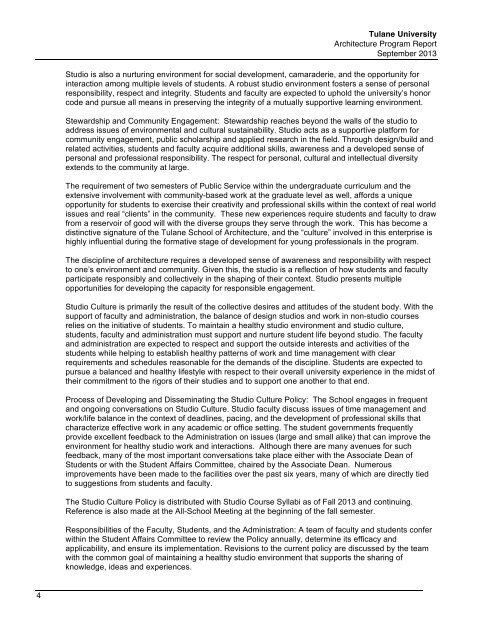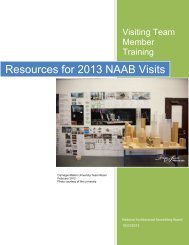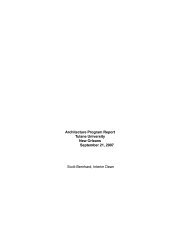NAAB Architecture Program Report (APR) 2013 - Tulane School of ...
NAAB Architecture Program Report (APR) 2013 - Tulane School of ...
NAAB Architecture Program Report (APR) 2013 - Tulane School of ...
You also want an ePaper? Increase the reach of your titles
YUMPU automatically turns print PDFs into web optimized ePapers that Google loves.
<strong>Tulane</strong> University<strong>Architecture</strong> <strong>Program</strong> <strong>Report</strong>September <strong>2013</strong>Studio is also a nurturing environment for social development, camaraderie, and the opportunity forinteraction among multiple levels <strong>of</strong> students. A robust studio environment fosters a sense <strong>of</strong> personalresponsibility, respect and integrity. Students and faculty are expected to uphold the university’s honorcode and pursue all means in preserving the integrity <strong>of</strong> a mutually supportive learning environment.Stewardship and Community Engagement: Stewardship reaches beyond the walls <strong>of</strong> the studio toaddress issues <strong>of</strong> environmental and cultural sustainability. Studio acts as a supportive platform forcommunity engagement, public scholarship and applied research in the field. Through design/build andrelated activities, students and faculty acquire additional skills, awareness and a developed sense <strong>of</strong>personal and pr<strong>of</strong>essional responsibility. The respect for personal, cultural and intellectual diversityextends to the community at large.The requirement <strong>of</strong> two semesters <strong>of</strong> Public Service within the undergraduate curriculum and theextensive involvement with community-based work at the graduate level as well, affords a uniqueopportunity for students to exercise their creativity and pr<strong>of</strong>essional skills within the context <strong>of</strong> real worldissues and real “clients” in the community. These new experiences require students and faculty to drawfrom a reservoir <strong>of</strong> good will with the diverse groups they serve through the work. This has become adistinctive signature <strong>of</strong> the <strong>Tulane</strong> <strong>School</strong> <strong>of</strong> <strong>Architecture</strong>, and the “culture” involved in this enterprise ishighly influential during the formative stage <strong>of</strong> development for young pr<strong>of</strong>essionals in the program.The discipline <strong>of</strong> architecture requires a developed sense <strong>of</strong> awareness and responsibility with respectto one’s environment and community. Given this, the studio is a reflection <strong>of</strong> how students and facultyparticipate responsibly and collectively in the shaping <strong>of</strong> their context. Studio presents multipleopportunities for developing the capacity for responsible engagement.Studio Culture is primarily the result <strong>of</strong> the collective desires and attitudes <strong>of</strong> the student body. With thesupport <strong>of</strong> faculty and administration, the balance <strong>of</strong> design studios and work in non-studio coursesrelies on the initiative <strong>of</strong> students. To maintain a healthy studio environment and studio culture,students, faculty and administration must support and nurture student life beyond studio. The facultyand administration are expected to respect and support the outside interests and activities <strong>of</strong> thestudents while helping to establish healthy patterns <strong>of</strong> work and time management with clearrequirements and schedules reasonable for the demands <strong>of</strong> the discipline. Students are expected topursue a balanced and healthy lifestyle with respect to their overall university experience in the midst <strong>of</strong>their commitment to the rigors <strong>of</strong> their studies and to support one another to that end.Process <strong>of</strong> Developing and Disseminating the Studio Culture Policy: The <strong>School</strong> engages in frequentand ongoing conversations on Studio Culture. Studio faculty discuss issues <strong>of</strong> time management andwork/life balance in the context <strong>of</strong> deadlines, pacing, and the development <strong>of</strong> pr<strong>of</strong>essional skills thatcharacterize effective work in any academic or <strong>of</strong>fice setting. The student governments frequentlyprovide excellent feedback to the Administration on issues (large and small alike) that can improve theenvironment for healthy studio work and interactions. Although there are many avenues for suchfeedback, many <strong>of</strong> the most important conversations take place either with the Associate Dean <strong>of</strong>Students or with the Student Affairs Committee, chaired by the Associate Dean. Numerousimprovements have been made to the facilities over the past six years, many <strong>of</strong> which are directly tiedto suggestions from students and faculty.The Studio Culture Policy is distributed with Studio Course Syllabi as <strong>of</strong> Fall <strong>2013</strong> and continuing.Reference is also made at the All-<strong>School</strong> Meeting at the beginning <strong>of</strong> the fall semester.Responsibilities <strong>of</strong> the Faculty, Students, and the Administration: A team <strong>of</strong> faculty and students conferwithin the Student Affairs Committee to review the Policy annually, determine its efficacy andapplicability, and ensure its implementation. Revisions to the current policy are discussed by the teamwith the common goal <strong>of</strong> maintaining a healthy studio environment that supports the sharing <strong>of</strong>knowledge, ideas and experiences.4














